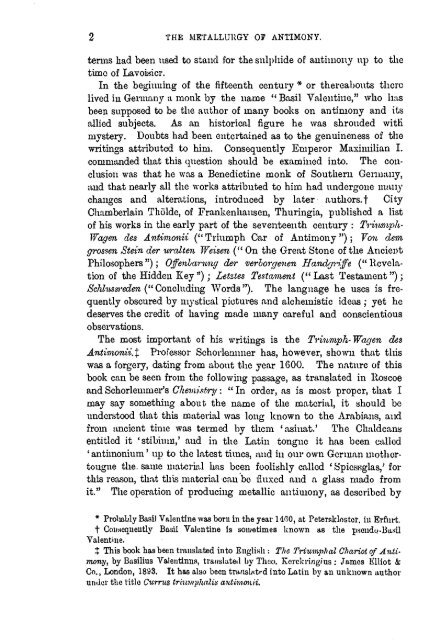antimony - Sciencemadness.org
antimony - Sciencemadness.org
antimony - Sciencemadness.org
You also want an ePaper? Increase the reach of your titles
YUMPU automatically turns print PDFs into web optimized ePapers that Google loves.
2 THE METALLURGY OF ANTIMONY.<br />
terms had been used to stand for the sulphide of <strong>antimony</strong> up to the<br />
time of Lavoisier.<br />
In the beginning of the fifteenth century * or thereabouts there<br />
lived in Germany a monk by the name " Basil Valentine," who has<br />
been supposed to be the author of many books on <strong>antimony</strong> and its<br />
allied subjects. As an historical figure he was shrouded vvitH<br />
mystery. Doubts had been entertained as to the genuineness of the<br />
writings attributed to him. Consequently Emperor Maximilian I.<br />
commanded that this question should be examined into. The conclusion<br />
was that he was a Benedictine monk of Southern Germany,<br />
and that nearly all the works attributed to him had undergone many<br />
changes and alterations, introduced by later authors, t City<br />
Chamberlain Tholde, of Frankenhausen, Thuringia, published a list<br />
of his works in the early part of the seventeenth century : Triumph-<br />
Wagen des Antimonii ("Triumph Car of Antimony"); Von dem<br />
grossen Stein der uralten Weisen (" On the Great Stone of the Ancient<br />
Philosophers "); Offenbarung der verlorc/e?ien Handgriffe (" Revelation<br />
of the Hidden Key ") ; Letztes Testament (" Last Testament");<br />
Schlussreden (" Concluding Words"). The language he uses is frequently<br />
obscured by mystical pictures and alchemistic ideas ; yet he<br />
deserves the credit of having made many careful and conscientious<br />
observations.<br />
The most important of his writings is the Triumph' Wagen des<br />
Antinionii.% Professor Schorlemmer has, however, shown that this<br />
was a f<strong>org</strong>ery, dating from about the year 1600. The nature of this<br />
book can be seen from the following passage, as translated in lloscoe<br />
and Schorlemmer's Chemistry: "In order, as is most proper, that I<br />
may say something about the name of the material, it should be<br />
understood that this material was long known to the Arabians, and<br />
from ancient time was termed by them 'asinat.' The Chaldeans<br />
entitled it 'stibium,' and in the Latin tongue it has been called<br />
c antimonium' up to the latest times, and in our own German mothertongue<br />
the. same material has been foolishly called ' Spicssglas,' for<br />
this reason, that this material can be fluxed and a glass mado from<br />
it." The operation of producing metallic <strong>antimony</strong>, as described by<br />
* Probably Basil Valentine was born in the year 14G0, at Peteraklostor, in Erfurt.<br />
t Consequently Basil Valentine is sometimes known as the pseudo-Basil<br />
Valentine.<br />
X This book has been translated into English : The Triumphal Chariot of Antimony,<br />
by BasiKus Valentinns, translated by Theo. Kerckringius: James Elliot &<br />
Co., London, 1893. It has also been translated into Latin by an unknown author<br />
under the title Currus triuwpJictlis antimonii.
















